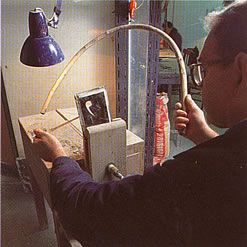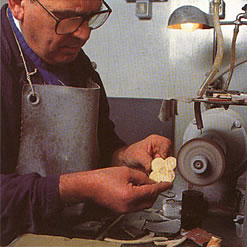 |
The
art of Florentine mosaic, an "intarsio" or inlay of hard stones
called" Commesso", is unique in the world. It flourished 500 years
ago at the court of the Medici and has been handed down to us by
a few craftsmen, generation to generation, through the centuries.
The technique of the mosaic was already known in ancient civilisation
but became perfected and found expression in inlay. In the mosaic,
to create forms and colours, small fragments of stone called "tesserae"
in uniform colour, without shading, were fit side by side in a generally
pre-established pattern.
With the use of inlay, the work became more dynamic. The tesserae
were no longer simply arranged according to established patterns,
but forms and materials were sought that when joined together would
give life to more forceful representations. During the Renaissance
this technique evolved further, finding its maximum expression in
the Florentine mosaic or "Commesso". Unlike the mosaic, the "Commesso"
is formed of hard and semiprecious stones (such as lapislazuli,malachite, green jasper of the Arno, coloured jasper, chalcedony, agate, onyx, etc.) variously cut to exploit natural shadings and
united to form a picture.
|
|
In
the centuries that followed there were still great mosaicists in
Florence but none with that splendid creative dynamism of the age
of Lorenzo the Magnificent. The technique of "Commesso" is concealed
in the hands and mind of the master craftsman. To describe the characteristics
of this art entails relating the personal experience of twenty or
thirty years of work. The technique has remained largely unchanged
in its 500 years. Many of the stones are imported, others are found
by the Florentine craftsmen themselves amongst the pebbles of the
Tuscan streams. The stones are roughly cut into sections 3 mm thick.
Then the various pieces are sawn by hand using patterned cards as
a base and model.
|
The saw is the same as those used in the 15th century a cherry branch bent to form a bow with an
iron wire stretched across end to end and moistened with water and abrasive powder. All the pieces
of the mosaic are glued with adhesive to a slate tablet and then polished. The work is done with
infinite care and patience, but problems may still arise: stones which seem beautiful on the surface
may prove to be full of sand or flaky when cut or easily break or change colour when exposed to the
light.
Experienced craftsmen overcome these problems with skill, making the final piece even more
precious. Florentine mosaics are displayed in the world's most famous museums: the Palazzo Pitti,
the Uffizi Gallery, the Prado, the British Museum and many others. There are other places in the
world today where a few people practise this art, but the tradition remains solidly in the hands of
Florentine master craftsmen.
|
 |
|

